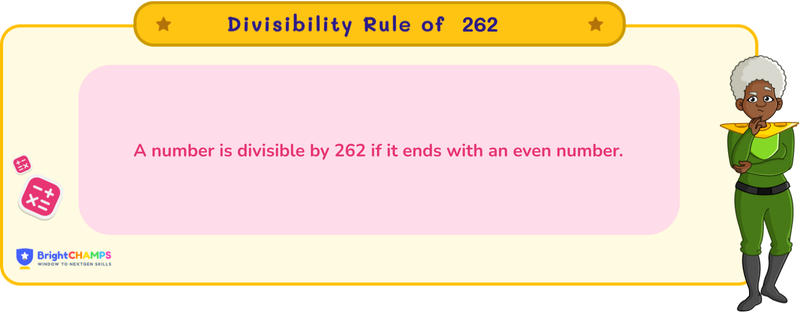Summarize this article:
 278 Learners
278 LearnersLast updated on August 5, 2025
Divisibility Rule of 262

The divisibility rule is a way to find out whether a number is divisible by another number without using the division method. In real life, we can use the divisibility rule for quick math, dividing things evenly, and sorting things. In this topic, we will learn about the divisibility rule of 262.

What is the Divisibility Rule of 262?
The divisibility rule for 262 is a method by which we can find out if a number is divisible by 262 or not without using the division method. Check whether 524 is divisible by 262 with the divisibility rule.
Step 1: Divide the number into two parts, here in 524, consider the first part as 5 and the second part as 24.
Step 2: Multiply the first part by 2, i.e., 5 × 2 = 10.
Step 3: Add the result from Step 2 to the second part, i.e., 10 + 24 = 34.
Step 4: If the result from Step 3 is 262 or a multiple of 262, then the number is divisible by 262. In this case, 34 is not a multiple of 262, so 524 is not divisible by 262.


Tips and Tricks for Divisibility Rule of 262
Learning the divisibility rule will help students master division. Let’s learn a few tips and tricks for the divisibility rule of 262.
Know the multiples of 262:
Memorize the multiples of 262 (262, 524, 786, 1048, etc.) to quickly check the divisibility. If the result from the addition is a multiple of 262, then the number is divisible by 262.
Use the division method to verify:
Students can use the division method as a way to verify and crosscheck their results. This will help them to verify and also learn.

Common Mistakes and How to Avoid Them in Divisibility Rule of 262
The divisibility rule of 262 helps us to quickly check if the given number is divisible by 262, but common mistakes like calculation errors lead to incorrect conclusions. Here we will understand some common mistakes and how to avoid them.
Explore Our Programs



Divisibility Rule of 262 Examples

Problem 1
Is 524 divisible by 262?

Yes, 524 is divisible by 262.
Explanation
To check the divisibility rule for 262, we follow these steps:
1) Double the last digit of the number, 4 × 2 = 8.
2) Subtract this result from the remaining digits, excluding the last digit, 52 – 8 = 44.
3) Check if 44 is a multiple of 262. Yes, subtracting 262 from 524 results in 262, confirming divisibility.

Problem 2
Check the divisibility rule of 262 for 1048.

Yes, 1048 is divisible by 262.
Explanation
To verify divisibility by 262, we perform the following:
1) Double the last digit of the number, 8 × 2 = 16.
2) Subtract this result from the remaining digits, excluding the last digit, 104 – 16 = 88.
3) Check if 88 is a multiple of 262. Since subtracting 262 from 1048 results in 786 and then 524, both multiples of 262, the number is divisible by 262.

Problem 3
Is 2620 divisible by 262?

Yes, 2620 is divisible by 262.
Explanation
Use these steps to check divisibility:
1) Double the last digit of the number, 0 × 2 = 0.
2) Subtract this result from the remaining digits, excluding the last digit, 262 – 0 = 262.
3) 262 is clearly a multiple of 262, confirming divisibility.

Problem 4
Can 785 be divisible by 262 following the divisibility rule?

No, 785 isn't divisible by 262.
Explanation
Checking divisibility involves the following:
1) Double the last digit of the number, 5 × 2 = 10.
2) Subtract this result from the remaining digits, excluding the last digit, 78 – 10 = 68.
3) Check if 68 is a multiple of 262. No, 68 isn't a multiple of 262, confirming indivisibility.

Problem 5
Check the divisibility rule of 262 for 1310.

Yes, 1310 is divisible by 262.
Explanation
To check divisibility by 262, follow these steps:
1) Double the last digit of the number, 0 × 2 = 0.
2) Subtract this result from the remaining digits, excluding the last digit, 131 – 0 = 131.
3) Subtract 262 from 1310 to get 1048, then 786, finally 524, all multiples of 262. Hence, 1310 is divisible by 262.


FAQs on Divisibility Rule of 262
1.What is the divisibility rule for 262?
2.How many numbers are there between 1 and 1000 that are divisible by 262?
3.Is 1048 divisible by 262?
4.What if I get 0 after adding?
5.Does the divisibility rule of 262 apply to all integers?

Important Glossaries for Divisibility Rule of 262
- Divisibility rule: The set of rules used to find out whether a number is divisible by another number or not.
- Multiples: Multiples are the results we get after multiplying a number by an integer. For example, multiples of 262 are 262, 524, 786, etc.
- Integers: Integers are the numbers that include all whole numbers, negative numbers, and zero.
- Addition: Addition is a mathematical operation that represents combining collections of objects together into a larger collection.
- Verification: The process of confirming the accuracy and validity of a calculation or result.



Hiralee Lalitkumar Makwana
About the Author
Hiralee Lalitkumar Makwana has almost two years of teaching experience. She is a number ninja as she loves numbers. Her interest in numbers can be seen in the way she cracks math puzzles and hidden patterns.
Fun Fact
: She loves to read number jokes and games.

















